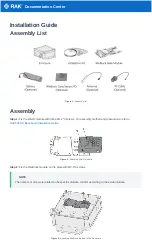
Teletrac, Inc. - Prism TM Information and Installation Guide
64
1622-0300
B1
3/18/04
Detailed Safety Information
Exposure to Radio Frequency Signals
The Prism TM is a low power radio transmitter and receiver. When it is ON, it receives
and also sends out radio frequency (RF) signals.
In August 1996, the Federal Communications Commissions (FCC) adopted RF exposure
guidelines with safety levels for hand-held wireless phones. Those guidelines are
consistent with safety standards previously set by both U.S. and international standards
bodies:
•
ANSI C95.1 (1992)
•
NCRP Report 86 (1986)
•
ICNIRP (1996)
Those standards were based on comprehensive and periodic evaluations of the relevant
scientific literature. For example, over 120 scientists, engineers, and physicians from
universities, government health agencies, and industry reviewed the available body of
research to develop the ANSI Standard (C95.1)
While the Prism TM is not intended for hand-held use, its design nonetheless complies
with the FCC guidelines (and those standards).
Electronic Devices
Most modern electronic equipment is shielded from RF signals. However, certain
electronic equipment may not be shielded against the RF signals generated by the Prism
TM.
Pacemakers
The Health Industry Manufacturers Association recommends that a minimum separation
of six (6”) inches be maintained between a handheld wireless phone and a pacemaker to
avoid potential interference with the pacemaker. These recommendations are consistent
with the independent research by and recommendations of Wireless Technology
Research.
Persons with pacemakers:
•
Should ALWAYS keep the Prism TM more than eight inches from their
pacemaker with the device is operational.
•
Should not carry the Prism TM on their person
•
If there is any reason to suspect that interference is taking place, the
Prism TM battery pack should be removed immediately.
Other Medical Devices
If any other personal medical devices are used in the vicinity of a Prism TM, consult the
manufacturers of the medical devices to determine if they are adequately shielded from
external RF energy. Physicians may be able to assist in obtaining this information.
Disable operation of the Prism TM by removing the battery pack in health care facilities
when any regulations posted in these areas prohibit the use of wireless phones or two-
way radios. Hospitals and health care facilities may be using equipment that could be
sensitive to external RF energy.
Summary of Contents for Prism TM
Page 2: ...Teletrac Inc Prism TM Information and Installation Guide 2 1622 0300 B1 3 18 04...
Page 4: ...Teletrac Inc Prism TM Information and Installation Guide 4 1622 0300 B1 3 18 04...
Page 6: ...Teletrac Inc Prism TM Information and Installation Guide 6 1622 0300 B1 3 18 04...
Page 18: ...Teletrac Inc Prism TM Information and Installation Guide 18 1622 0300 B1 3 18 04...
Page 20: ...Teletrac Inc Prism TM Information and Installation Guide 20 1622 0300 B1 3 18 04...
Page 27: ...Teletrac Inc Prism TM Information and Installation Guide 1622 0300 B1 3 18 04 27...
Page 35: ...Teletrac Inc Prism TM Information and Installation Guide 1622 0300 B1 3 18 04 35...
Page 39: ...Teletrac Inc Prism TM Information and Installation Guide 1622 0300 B1 3 18 04 39...
Page 49: ...Teletrac Inc Prism TM Information and Installation Guide 1622 0300 B1 3 18 04 49...
Page 53: ...Teletrac Inc Prism TM Information and Installation Guide 1622 0300 B1 3 18 04 53...
Page 59: ...Teletrac Inc Prism TM Information and Installation Guide 1622 0300 B1 3 18 04 59...
Page 61: ...Teletrac Inc Prism TM Information and Installation Guide 1622 0300 B1 3 18 04 61...



































